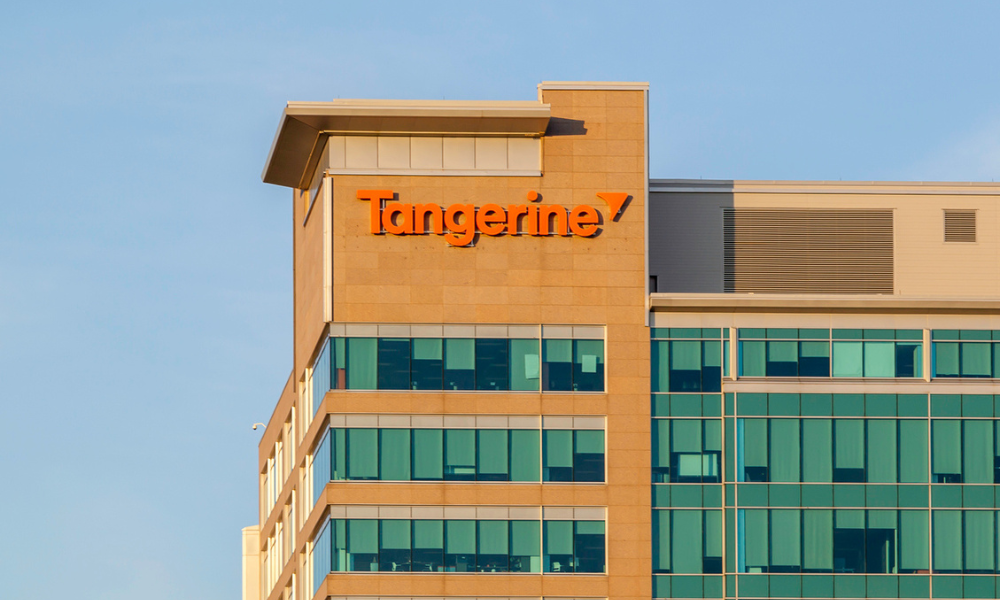Formerly ING Direct, Tangerine Bank is one of Canada’s largest online-only banks. Does this mean you should buy stock in Tangerine? Find out here

Banks are essential businesses in any economy, so it’s not surprising that their stocks are among the most stable investments. While they still have inherent risk and volatility, savvy investors prefer to hold bank stocks as they often appreciate, hold their value over time, and can be resilient in economic downturns.
Bank stocks like those of the Big Five banks are some of the most reliable and therefore favoured investments in Canada. But what about other bank stocks apart from the Big Five? Can they be viable investments as well?
In this article, WealthProfessional focuses on one bank that is not among the Big Five, Tangerine Bank.
So, should investors buy stocks in Tangerine Bank? Let’s find out.
Buying Shares in Tangerine Bank
Given that Tangerine Bank looks like a viable investment on paper, should you buy Tangerine stocks and what is the Tangerine bank stock price now? Can I buy stocks in Tangerine? To answer these questions, we have bad news and good news.
Bad news first: to date, Tangerine Bank has not had an IPO of its shares ever since it was acquired by Scotiabank. As of now, investors cannot buy any shares of stock in Tangerine Bank.
The good news? Tangerine may not offer shares of its own, but there are a couple of workarounds.
- You can choose from the many products of Tangerine and invest in stocks with them at competitive rates.
- Investors can buy shares in their parent company – Scotiabank, which is one of the best Canadian bank stocks you can invest in now.
How to Invest with Tangerine Bank
Since Tangerine is an online-only digital bank, it’s easy to make investments with them. You can simply use your computer, phone, or mobile device to create an account. Just follow the instructions, and you can start opening an investment fund account with Tangerine, then assemble your portfolio of stocks, bonds, mutual fund investments, and ETFs.

What investment products does Tangerine offer?
Tangerine investments include a wide range of products:
- RRSPs
- TFSAs
- GICs
- mutual funds
- zero-fee daily chequing accounts
Since we’re talking about stocks, investors can place money into their line of stock portfolios. Here are the stock portfolios investors can choose from with Tangerine:
- Core Portfolios – This is a collection of different stock portfolios in large Canadian companies to suit investors’ financial goals. Investors can have their pick of dividend-paying portfolios, balanced income portfolios, and other portfolio types to suit investors’ risk tolerance, goals, and time horizon.
- Global ETF Portfolios – A collection of Exchange-Traded Funds placed in a mutual fund; these are stocks from different global companies. Global ETF portfolios from Tangerine offer greater diversification, substantial growth potential, and less risk, as its asset allocation is 70% bonds and 30% stocks.
- Socially Responsible Global Portfolios – This portfolio is designed for investors who prefer to have shares and invest in companies that reflect their values. Tangerine’s portfolio of ethical investments is meant to cater to the needs of the ESG investor.
One of the drawbacks of a mutual funds account with Tangerine investments is that investors cannot pick individual stocks for their portfolios. They will have to choose from a selection of pre-assembled portfolios.
Another disadvantage is that the fees can be quite hefty compared to other banks or platforms, as Tangerine charges about 1.07% on investments. What this digital bank has going for itself are the other services like the credit card facility and the zero-fee chequing account. Watch this video for more details about Tangerine:
It’s worth noting that your investments in Tangerine are safe, since your portfolio will be in capable hands. That's because these investment funds are managed by Tangerine Investment Funds, which in turn is managed by 1832 Asset Management L.P. and are only distributed by Tangerine Investment Funds Limited. Investors might be pleased to know that both companies are wholly owned subsidiaries of Scotiabank.
What do I need to know about Tangerine Bank?
What is Tangerine bank? Tangerine bank is unlike most conventional banks in that it is a digital bank. This means that it has no physical, brick-and-mortar branches. A few decades ago, Tangerine bank did business in a different way and had a different name – ING Direct.
Tangerine Bank had its start way back in 1997, and back then it was known as ING Bank of Canada but operated under the name of ING Direct. At that time, the bank served clients as a phone banking service that offered only savings accounts. You could say that the ING Group was ahead of its time, since they used ING Direct as a test bed for their envisioned business model. ING aimed at offering more favourable interest rates to customers by defraying the costs of having a network of brick-and-mortar branches.
Some years later in 2012, ING was acquired by the Bank of Nova Scotia, or what is more commonly known as Scotiabank. This cost about $3.1 billion for Scotiabank to buy ING Direct from the ING Group. Part of the acquisition's terms was to rename the bank before May of 2014.
So, on November 5, 2013, ING Direct Canada revealed that its name would become “Tangerine Bank” by early 2014. It was revealed that the name change was the result of a year-long qualitative and quantitative research study involving 10,000 people. Tangerine Bank still uses the “Forward Banking” slogan that has been used by ING Direct Canada from 2012 onwards. Before 2012, ING Direct Canada used the tagline "Save Your Money”.
Now that the bank has evolved into online banking, Tangerine expanded from only offering savings accounts to mortgages, TFSAs, RRSPs, GICs, mutual funds, and chequing accounts that charge zero fees.
Today, Tangerine Bank services over 2 million customers across Canada, employs 1,200 staff, and has $47 billion in total assets. To know more about this digital bank, check out their company profile on our website.
Investing in Scotiabank
The other option is to buy into Tangerine’s parent company, Scotiabank. Buying Scotiabank stock, even for beginning investors, can be an easy decision to make since Scotiabank remains one of Canada’s Big Five Banks.
Why invest in bank stocks
In the past, savvy advisors and investors would choose not to invest in bank stocks, especially if there was a recession on the horizon. According to some experts, that unwritten rule no longer applies. But in general, there are a few good reasons for investing in bank stocks:
- Banks are cyclical businesses – What this means is that banks follow economic cycles, so there is some measure of predictability in their behaviour. Bank stocks, being cyclical in nature, will inevitably rise during economic expansion and decline during economic recession. Having some predictability in a stock makes it easier for investors to create a diverse portfolio of stocks that can balance growth potential and stability.
- Banks are heavily regulated – Few other businesses or industries are as heavily monitored and regulated as the banking industry. This became more strictly regulated after the financial crisis of 2008-2009 that threatened North America’s banking system. Banks typically must maintain a minimum capital requirement to operate, so that makes their stock inherently stable.
- Bank stocks can be backed by investment banking – Commercial or retail banking activities are often hard-hit during recessions, but banks with an interest in investment banking can do better in these times. Banks that dabble in investment banking do mergers and acquisitions, debt and equity underwriting, wealth management for high-net-worth clients, IPOs, and other business activities that involve a lot of money. The stocks of banks that engage in these activities can mitigate a lot of risk and provide some returns, even in tough times.
- Banks are more resilient – With rising inflation and interest rates, banks are emerging as sturdier and profitable businesses. As economic recession spreads, central banks are forced to raise interest rates.
This is beneficial for banks, as they can earn bigger returns on loans to businesses and households, and as more workers place their money in savings accounts. These factors can contribute to a rise in the price of bank stocks.
Indicators of a good bank stock
When the time comes that Tangerine has its IPO, or if you convince your clients to invest in Scotiabank, make sure to check their indicators. Here are the stock indicators to look at before you or your clients take the plunge:
-
Market capitalization (market cap) is the value of all a company’s shares. A bank's or company's market cap can be a good indicator of its growth potential and can give investors a better picture of its standing relative to its competitors and its industry at large.
-
market cap = total number of outstanding shares x share price
-
-
Price-to-book or (P/B) value ratio is a ratio that compares the current market cap of a company with its accounting value. A company’s stock is deemed a good investment if it has a low P/B ratio, as this means investors can or are paying less for the actual book value of the stocks.
-
P/B value ratio = company’s stock price per share ÷ book value per share
-
-
Price to Earnings (P/E) ratio is the ratio that shows whether the company’s stock price is higher or lower compared to the company’s revenues.
-
P/E ratio = current share price ÷ earnings per share (EPS)
-
-
Earnings Per Share (EPS) can show how much money a company earns for each share of its stock. In many cases, the EPS can be seen as a reliable measure of a company’s value.
-
EPS = (net income – company's preferred dividends) ÷ number of outstanding shares
-
-
Dividend Payout Ratio (DPR) shows how much a company pays out to investors in dividends compared to the earnings of the stock. The DPR is an indicator of a company’s earnings and how well it can cover dividends.
-
DPR = annual dividend per share ÷ EPS
-
-
Dividend yield is the amount that a company pays relative to its stock price. In most cases, companies pay dividends yearly although it is not unusual for a company to make quarterly dividend payments.
-
Dividend yield = annual dividend per share ÷ price per share
-
When the day comes that Tangerine has its IPO, give it some time and refer to their stock indicators before investing into its stock. The stock’s value may decline, but given that it’s a digital bank, it should fare better than other IPOs that fared worse in the recent past, like some tech stocks.
Apart from checking the stock indicators, here are some important things to consider before investing in a bank stock, whether it’s Scotiabank, Tangerine (if it goes public), or any other bank:
- Have reasonable expectations. Don’t make the mistake of thinking that you can make your client wealthy overnight or within a short period of time. Don’t give investors unrealistic expectations either; that will only set them up for disappointment. Accept that building wealth takes time.
- Think of what you can gain but be mindful of the risks. Remember: the higher the potential returns on your investment, the higher the risk of loss.
- Understand what you are investing in. Never blindly invest your client’s money in companies, funds, or other investments you know nothing about. While you don’t need to be an expert about what you invest in, at least understand how they earn and how they can potentially lose. It also helps to know if the investment has any trailing commissions, management fees and expenses. Also, don’t forget the legal stuff, like income taxes and the necessary paperwork.
- Always diversify your investments. The old saying “never put all your eggs in one basket” applies to stocks and investing in general. Don’t invest exclusively in bank stocks; mix it up with different types. A diversified portfolio with a variety of stocks and asset classes can better cushion the blow of other losing stocks.
- Past performance is never an indication of future performance. Be mindful that markets fluctuate frequently, and past performance is no guarantee the markets will stay that way. For instance, bank stocks may be performing well today, but that is no guarantee they will still do well tomorrow. Conversely, if they are performing badly today, there is no guarantee either that they will still perform badly tomorrow.
Whether Tangerine bank issues an IPO or if such a bank will be allowed to have an IPO in the future is anyone’s guess. Pragmatic investors shouldn’t wait for their stocks, not when they still have their pick of thousands of different stocks. Apart from the stocks of the Big Five banks of Canada, investors can also choose from the best Blue-chip stocks in Canada and hold them as long-term investments.
If Tangerine ever has an IPO, would you consider investing in its shares? Don’t forget, you can also take a look at other bank stocks for your portfolio.



